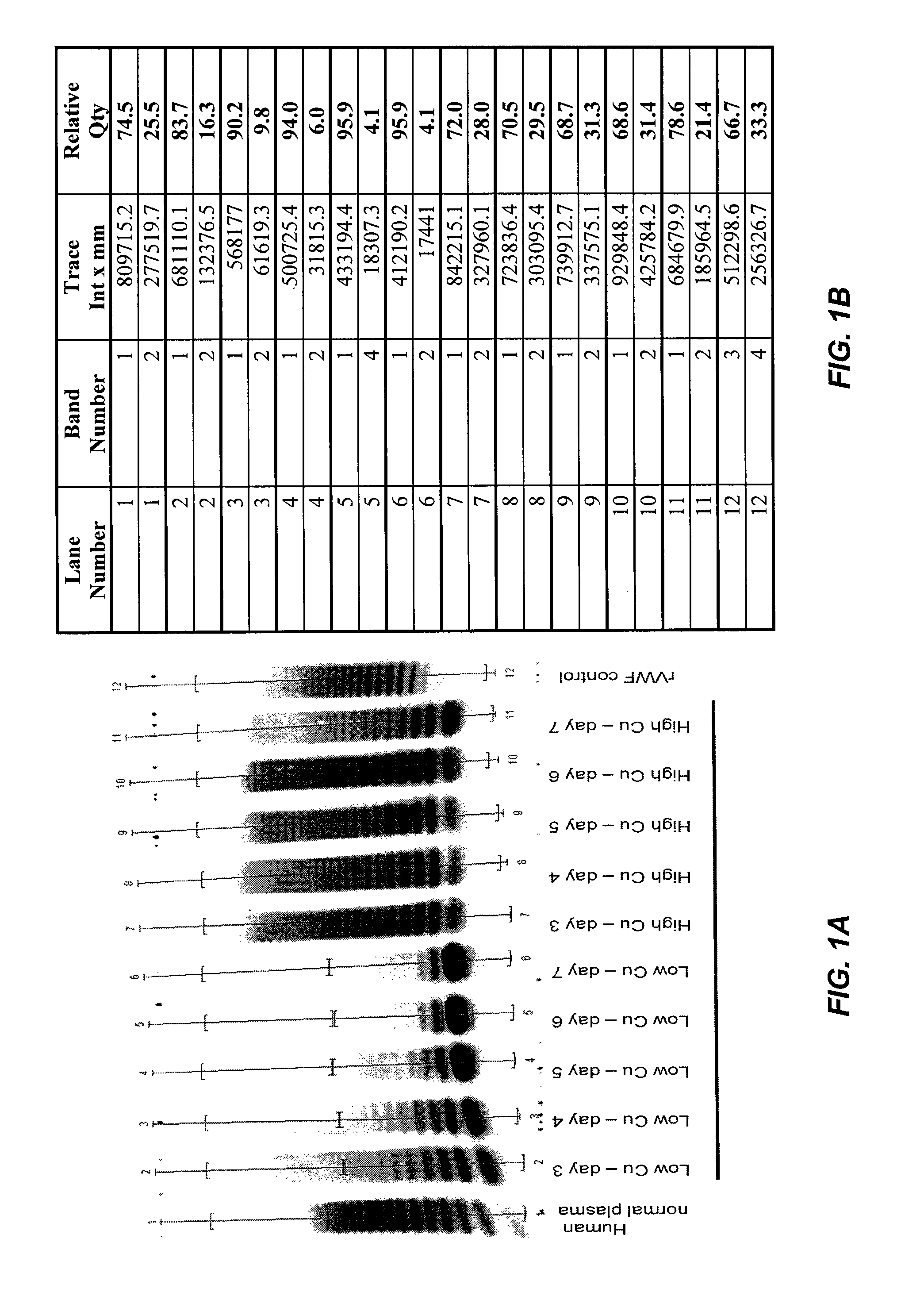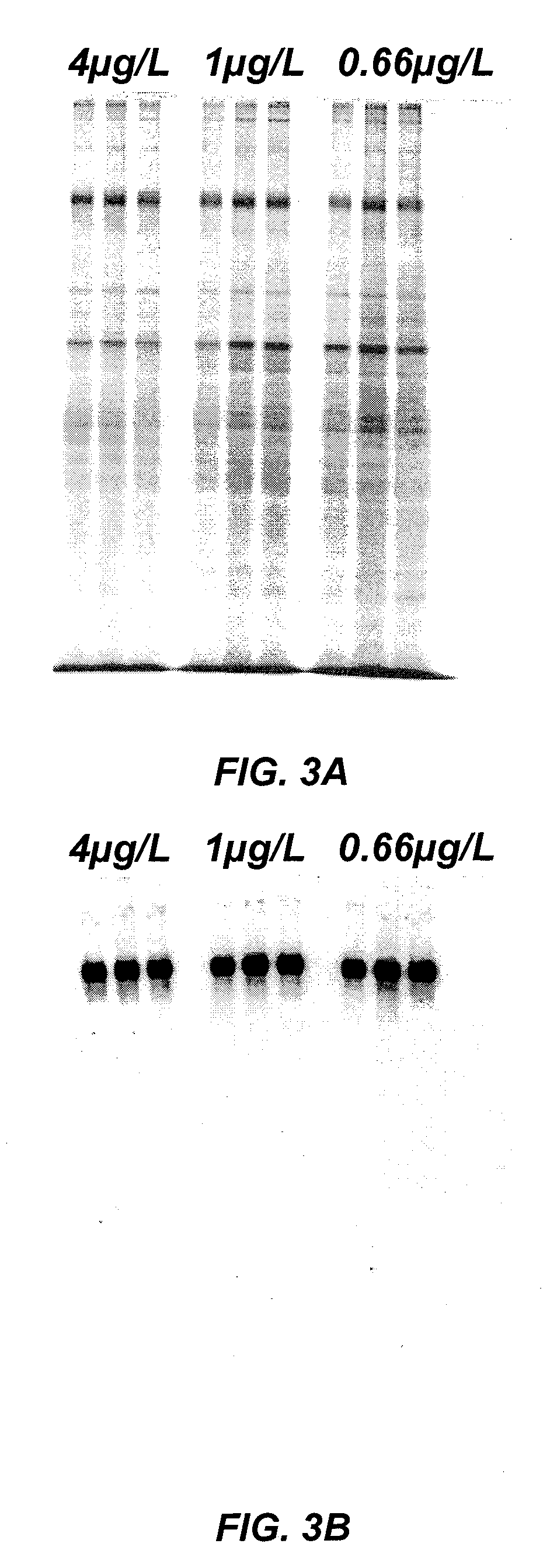Method of producing recombinant high molecular weight vWF in cell culture
a cell culture and high molecular weight technology, applied in the field of recombinant expression of therapeutic proteins in cell culture, can solve the problems of decreased total and specific activity, reduced protein production, and bse contamination of bovine serum and products derived thereof, and achieve the effect of improving protein expression and enzymatic activity
- Summary
- Abstract
- Description
- Claims
- Application Information
AI Technical Summary
Benefits of technology
Problems solved by technology
Method used
Image
Examples
example 1
[0318]Continuous cell culture experiments were performed using cultures of a recombinant CHO cell line expressing vWF. The basal medium was DMEM / F12, which contained about 0.3 μg / L of Cu2+. The medium was supplemented with soy hydrolysate and copper sulfate (CuSO4.5H2O) to bring the final copper concentration in the medium to greater than at least 2.4 μg / L.
[0319]Recombinant CHO cells expressing vWF were cultivated by continuous cell cultures so that the ammonium levels (NH4+) were kept at a concentration less than about 10 mM. It was found that production systems providing a continuous supply of medium (e.g., perfusion or chemostat cultures) were preferable because conventional batch or fed batch techniques produced high NH4+ concentrations at the end of the culture. At the end of the culture, the highly multimeric vWF was isolated and the specific Ristocetin Cofactor activity of the vWF was measured.
example 2
[0320]Recombinant Factor VIII (rFVIII) and Von Willebrand Factor (rVWF) were co-expressed in batch cultures of GD8 / 6 cells to determine the effect of the composition of the culture medium on VWF expression and activity. Briefly, GD8 / 6 cells were batch cultivated in BAV-SP medium composed of a modified DMEM / F12 basal powder (Table 5) and additional supplements also containing 4 g / L of soy hydrolysate, see Table 6, with and without additional copper supplementation. To test the effect of low copper concentraions on rVWF expression and activity, basal BAV-SP media was used. The basal media contained 0.3 μg / L copper and was supplemented with soy hydrolysate, which contributed an additional 0.7 μg / L copper, as determined experimentally, providing a final copper concentration of 1.0 μg / L. As a comparision, the BAV-SP media used for the batch cultures was further supplemented with an additional 3.3 μg / L of Cu2+, providing a final copper concentration of 4.3 μg / L, to determine the effect hi...
example 3
[0330]Recombinant Factor VIII (rFVIII) and Von Willebrand Factor (rVWF) were co-expressed in continuous cultures of GD8 / 6 cells operated under chemostatic conditions to determine the effect of the composition of the culture medium on VWF expression and activity. Briefly, GD8 / 6 cells were cultivated in BAV-SP medium containing 4 g / L of soy hydrolysate with and without copper supplementation as described in Example 2. To test the effect of low copper concentraions on rVWF expression and activity, basal BAV-SP media was used. The basal media contained 0.3 μg / L copper and was supplemented with soy hydrolysate, which contributed an additional 0.7 μg / L copper, providing a final copper concentration of 1.0 μg / L. As a comparision, the BAV-SP media used for the batch cultures was further supplemented with an additional 3.3 μg / L of Cu2+, providing a final copper concentration of 4.3 μg / L, to determine the effect high copper concentrations on VWF expression and activity. Cultures grown in the ...
PUM
| Property | Measurement | Unit |
|---|---|---|
| concentration | aaaaa | aaaaa |
| concentration | aaaaa | aaaaa |
| concentration | aaaaa | aaaaa |
Abstract
Description
Claims
Application Information
 Login to View More
Login to View More - R&D
- Intellectual Property
- Life Sciences
- Materials
- Tech Scout
- Unparalleled Data Quality
- Higher Quality Content
- 60% Fewer Hallucinations
Browse by: Latest US Patents, China's latest patents, Technical Efficacy Thesaurus, Application Domain, Technology Topic, Popular Technical Reports.
© 2025 PatSnap. All rights reserved.Legal|Privacy policy|Modern Slavery Act Transparency Statement|Sitemap|About US| Contact US: help@patsnap.com



